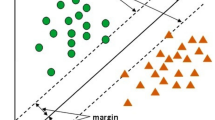Abstract
The efficiency of a number of the classical methods of supervised classification of hyperspectral data is estimated by an example of discriminating the types of the underlying surface in natural and man-made areas. The minimum distance, support vector machine, Mahalanobis, and maximum likelihood methods are considered. Particular attention is paid to studying the dependence of the data classification accuracy on the number of spectral features and the way of choosing them in the above-mentioned methods. Experimental results obtained by processing real hyperspectral images of landscapes of various types are reported.
Similar content being viewed by others
References
V. N. Ostrikov, O. V. Plakhotnikov, and A. V. Kirienko, “Processing of Hyperspectral Data Obtained from Aviation and Space Carriers,” Sovr. Probl. Dist. Zond. Zemli iz Kosmosa 10 (2), 243–251 (2013).
T. H. Chan, A. Ambikapathi, W. K. Ma, and C. Y. Chi, “Robust Affine Set Fitting and Fast Simplex Volume Max-Min for Hyperspectral Endmember Extraction,” IEEE Trans. Geosci. Remote Sensing 51 (7), 3982–3997 (2013).
K. Cawse-Nicholson, S. B. Damelin, A. Robin, and M. Sears, “Determining the Intrinsic Dimension of a Hyperspectral Image Using Random Matrix Theory,” IEEE Trans. Image Process. 22 (4), 1301–1310 (2013).
S. M. Borzov, A. O. Potaturkin, and O. I. Potaturkin, “Change Detection in Build-up Areas on the Basis of Structural Features of Satellite Images,” Avtometriya 51 (4), 3–11 (2015) [Optoelectron., Instrum. Data Process. 51 (4), 321–328 (2015)].
S. M. Borzov and O. I. Potaturkin, “Classification of Vegetation Types on the Basis of Hyperspectral Data of Remote Sensing,” Vestnik NGU, Ser. Inform. Tekhnol., No. 4, 13–22 (2014).
O. I. Potaturkin, S. M. Borzov, A. O. Potaturkin, and S. B. Uzilov, “Methods and Technologies of Processing of High-Resolution Multi- and Hyperspectral Data of Remote Sensing,” Vych. Tekhnol. 18 (special issue), 53–60 (2013).
F. A. Kruse, A. B. Lefkoff, J. B. Boardman, et al., “The Spectral Image Processing System (SIPS) — Interactive Visualization and Analysis of Imaging Spectrometer Data,” Remote Sensing of Environment 44 (2–3), 145–163 (1993).
H. Du, C. Chang, H. Ren, et al., “New Hyperspectral Discrimination Measure for Spectral Characterization,” Opt. Eng. 43 (8), 1777–1786 (2004).
T. Joachims, “Making Large-Scale Support Vector Machine Learning Practical,” in Advances in Kernel Methods — Support Vector Learning, Eds. by B. Schoelkopf, C. J. C. Burges, and A. J. Smola (MIT Press, Cambridge, USA, 1999, pp. 169–184).
J. A. Richards, Remote Sensing Digital Image Analysis (Springer-Verlag, Berlin, 2013, 494 pp.).
A. A. Green, M. Berman, P. Switzer, and M. D. Craig, “A Transformation for Ordering Multispectral Data in Terms of Image Quality with Implications for Noise Removal,” IEEE Trans. Geosci. Remote Sensing 26 (1), 65–74 (1988).
A. Plaza, J. A. Benediktsson, J. W. Boardman, et al., “Recent Advances in Techniques for Hyperspectral Image Processing,” Remote Sensing of Environment 113 (Suppl. 1), 110–122 (2009).
V. G. Bondur, “Modern Approaches to Processing Large Fluxes of Hyperspectral and Multispectral Aerospace Information,” Issled. Zemli iz Kosmosa, No. 1, 4–16 (2014).
C. Chen, W. Li, E. W. Tramel, et al., “Spectral-Spatial Preprocessing Using Multihypothesis Prediction for Noise-Robust Hyperspectral Image Classification,” IEEE J. Sel. Top. Appl. Earth Observ. Remote Sens. 7 (4), 1047–1059 (2014).
Author information
Authors and Affiliations
Corresponding author
Additional information
Original Russian Text © S.M. Borzov, A.O. Potaturkin, O.I. Potaturkin, A.M. Fedotov, 2016, published in Avtometriya, 2016, Vol. 52, No. 1, pp. 3–14.
About this article
Cite this article
Borzov, S.M., Potaturkin, A.O., Potaturkin, O.I. et al. Analysis of the efficiency of classification of hyperspectral satellite images of natural and man-made areas. Optoelectron.Instrument.Proc. 52, 1–10 (2016). https://doi.org/10.3103/S8756699016010015
Received:
Published:
Issue Date:
DOI: https://doi.org/10.3103/S8756699016010015



